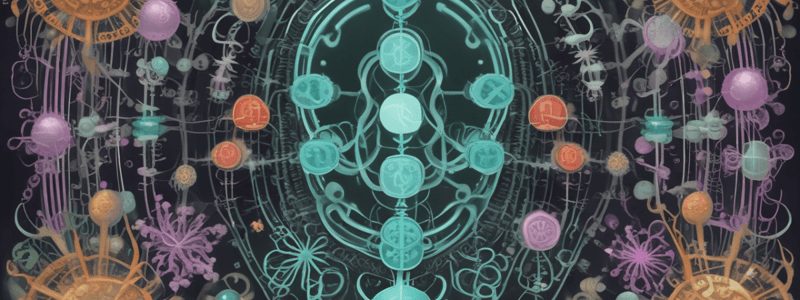Podcast
Questions and Answers
What is the primary goal of nitrogen fixation?
What is the primary goal of nitrogen fixation?
- To synthesize chlorophyll in plants
- To transform atmospheric nitrogen into bioavailable forms (correct)
- To produce energy for prokaryotes
- To convert ammonia into gaseous nitrogen
What is the name of the enzyme responsible for nitrogen fixation in prokaryotes?
What is the name of the enzyme responsible for nitrogen fixation in prokaryotes?
- ATPase
- Nitrogenase (correct)
- Photosynthase
- Chlorophyllase
Why is nitrogen fixation essential for plants?
Why is nitrogen fixation essential for plants?
- To regulate metabolic functions
- To maintain DNA structure
- To synthesize ATP molecules
- To produce chlorophyll for photosynthesis (correct)
What is the term for prokaryotes that can fix nitrogen?
What is the term for prokaryotes that can fix nitrogen?
What is the energy cost of nitrogen fixation per molecule?
What is the energy cost of nitrogen fixation per molecule?
What is the role of nitrogen-fixing soil bacteria in ecosystems?
What is the role of nitrogen-fixing soil bacteria in ecosystems?
What do legumes provide to Rhizobium bacteria in a mutualistic relationship?
What do legumes provide to Rhizobium bacteria in a mutualistic relationship?
What is the purpose of nitrogen fixation in the nitrogen cycle?
What is the purpose of nitrogen fixation in the nitrogen cycle?
What is the byproduct of nitrogen fixation by diazotrophic microorganisms?
What is the byproduct of nitrogen fixation by diazotrophic microorganisms?
What is the role of nitrification in the nitrogen cycle?
What is the role of nitrification in the nitrogen cycle?
What is a characteristic of marine nitrogen fixation?
What is a characteristic of marine nitrogen fixation?
Why are plants dependent on nitrogen-fixing bacteria and archaea?
Why are plants dependent on nitrogen-fixing bacteria and archaea?
What is the role of cyanobacteria like Prochlorococcus in marine ecosystems?
What is the role of cyanobacteria like Prochlorococcus in marine ecosystems?
How do humans acquire nitrogen?
How do humans acquire nitrogen?
What is the importance of the nitrogen cycle in ecosystems?
What is the importance of the nitrogen cycle in ecosystems?
Flashcards are hidden until you start studying
Study Notes
Nitrogen Fixation Definition
- Nitrogen fixation is a biochemical process that transforms atmospheric nitrogen (N2) into ammonia (NH3), ammonium (NH4+), or other bioavailable forms of nitrogen for eukaryotes.
- Prokaryotes, such as bacteria and archaea, are capable of nitrogen fixation using the enzyme nitrogenase, consuming 16 ATP molecules in the process.
Nitrogen Cycle
- Nitrogen fixation is the first step in the nitrogen cycle, which cycles atmospheric nitrogen to the living biosphere.
- The nitrogen cycle includes: biological nitrogen fixation, nitrification, ammonification, assimilation, and denitrification.
- Nitrogen-fixing bacteria develop symbiotic relationships with plants, providing bioavailable nitrogen in exchange for sugar and nutrients.
Importance of Nitrogen Fixation
- Nitrogen fixation is vital for ecosystems, as plants and animals rely on bioavailable nitrogen for metabolic and biological functions.
- Plants require nitrogen for photosynthesis, chlorophyll production, and other cellular processes.
- Humans indirectly depend on the nitrogen cycle through dietary sources, obtaining nitrogen from plants and animals that have incorporated nitrogen in their bodies.
Nitrogen Fixation Examples
- Terrestrial examples include mutualistic bacteria like Rhizobium, which fix nitrogen for legumes like beans and lentils.
- Marine examples include free-floating diazotrophic microorganisms like cyanobacteria, which fix atmospheric nitrogen into bioavailable forms for primary producers like Prochlorococcus.
Nitrogen Cycle Steps
- Biological nitrogen fixation: Atmospheric nitrogen is transformed into ammonia by free-living prokaryotic organisms in the soil or mutualistic bacteria in plant roots.
- Nitrification: Ammonia is converted into nitrates (NO3-) by prokaryotic nitrifying bacteria, and nitrates are further converted into nitrites (NO2-).
- Ammonification: Nitrogen-containing compounds are returned to the soil via animal waste or decomposition, converted to ammonia by soil bacteria.
- Assimilation: Bioavailable nitrogen is absorbed by eukaryotic organisms in the soil, like plants.
- Denitrification: Bioavailable nitrogen is transformed back into nitrogen gas, returned to the atmosphere.
Studying That Suits You
Use AI to generate personalized quizzes and flashcards to suit your learning preferences.




